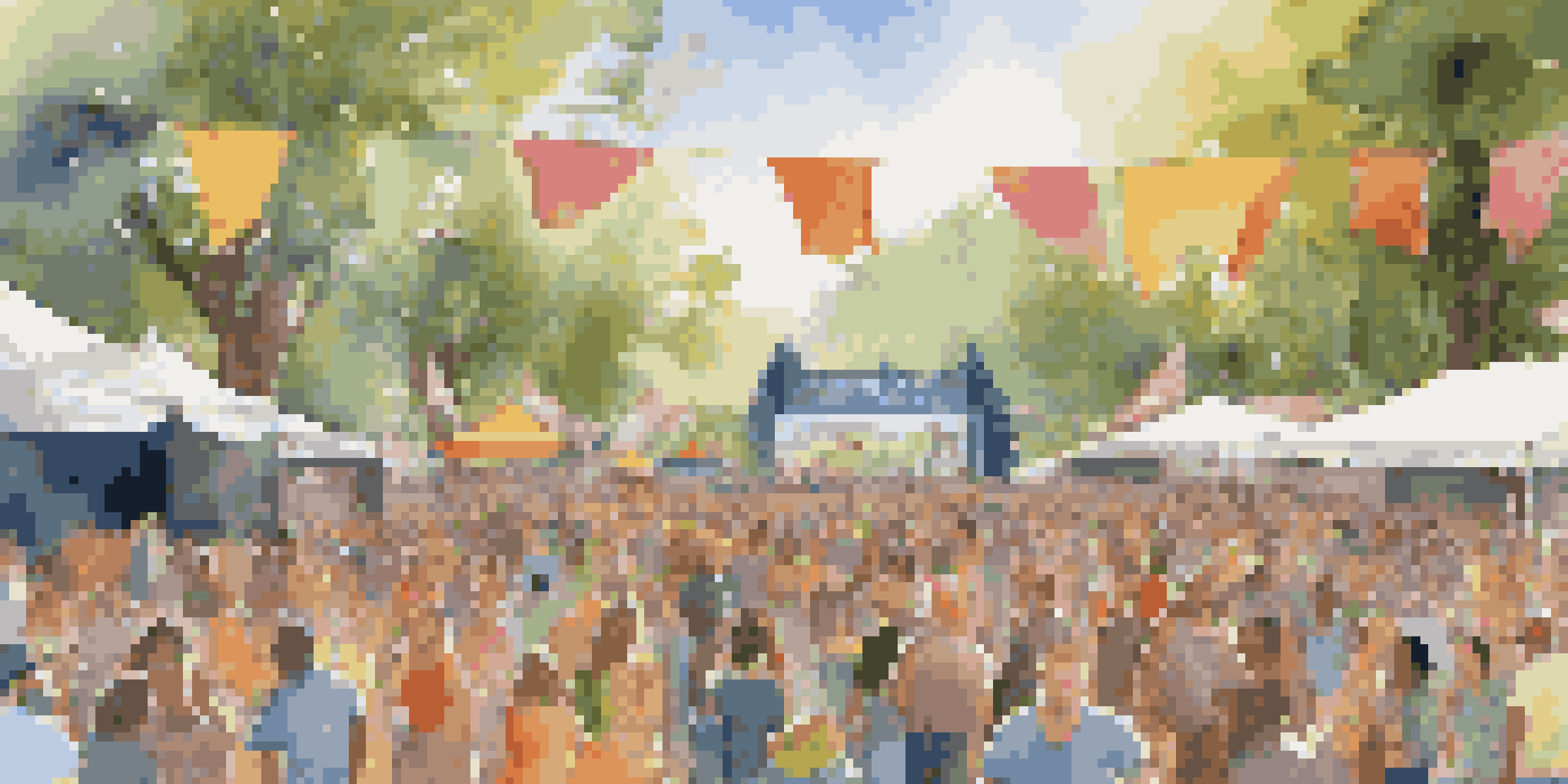The Relationship Between Music and Wildlife Conservation

Music as a Tool for Raising Awareness
Music has a unique way of connecting people to important causes, including wildlife conservation. Through benefit concerts and awareness campaigns, artists can evoke emotions and inspire action, making the plight of endangered species more relatable. For instance, songs that highlight the beauty of nature can motivate listeners to support conservation efforts.
Music can change the world because it can change people.
When a popular musician dedicates a song to a specific animal or habitat, it draws attention to the issues these creatures face. This connection can lead to increased donations to conservation organizations and a broader audience willing to get involved. Music not only entertains but also serves as a powerful vehicle for change.
Furthermore, collaborations between musicians and conservation groups can amplify messages. By combining melodies with impactful storytelling, they can reach diverse audiences, fostering a community that cares about wildlife and their habitats.
Soundscapes: The Natural Music of Wildlife
Wildlife is surrounded by its own natural symphony, often referred to as soundscapes. These soundscapes consist of the calls of animals, rustling leaves, and flowing water, creating an intricate auditory environment. Understanding these sounds helps researchers monitor animal populations and their behaviors in various ecosystems.

For example, scientists can use recordings of bird songs to identify species and assess their breeding success. In some cases, they even use sound to detect the presence of endangered species that may be elusive to visual observation. This intersection of music and science highlights the importance of listening to nature as a means of conservation.
Music Connects People to Causes
Through benefit concerts and songs dedicated to wildlife, music inspires emotional connections that drive support for conservation efforts.
Moreover, soundscapes can serve as indicators of ecosystem health. A diverse array of sounds usually signals a thriving environment, while diminished sound can signify distress or decline. By studying these changes, conservationists can take proactive steps to protect vulnerable habitats.
Musical Projects Supporting Wildlife Conservation
Numerous musical projects have sprung up around the globe, directly supporting wildlife conservation. For instance, the 'Songs for a Sustainable Planet' initiative invites artists to create music that emphasizes environmental themes. These projects not only raise funds but also educate listeners about the importance of biodiversity.
The power of music is such that it can make a difference in the world, especially when it is for a cause as important as wildlife conservation.
One notable example is the collaboration between musicians and wildlife documentaries, where original scores enhance the storytelling experience. This fusion of art and conservation captivates audiences, sparking interest in the featured species and their habitats. As viewers enjoy the music, they also learn about the urgent need for protection.
Additionally, festivals focusing on eco-friendly practices often feature performances that promote conservation messages. These events create a platform for artists to engage with fans while championing wildlife protection, ultimately fostering a sense of community around shared values.
How Music Can Influence Conservation Behavior
Research shows that music can significantly influence people's behavior and decision-making. For instance, studies have found that certain genres of music can evoke feelings of empathy, making listeners more likely to support conservation initiatives. This emotional connection can lead to increased participation in wildlife conservation activities, such as volunteering or donating.
Moreover, music can serve as a persuasive tool in educational settings. When conservation messages are paired with catchy tunes, students are more likely to remember the information. This can result in a generation that is more aware of and engaged in environmental issues.
Natural Soundscapes Indicate Health
Wildlife soundscapes help researchers monitor ecosystems, providing insights into animal populations and the health of their habitats.
In essence, the right musical backdrop can transform how individuals view wildlife conservation, turning apathy into action. By harnessing the power of music, organizations can effectively communicate their messages and motivate people to make a difference.
The Role of Music Festivals in Conservation
Music festivals have become increasingly popular platforms for promoting wildlife conservation. Many festivals now incorporate environmental initiatives, such as reducing waste and supporting local ecosystems. By attending these events, festival-goers not only enjoy great music but also learn about conservation efforts.
For example, festivals often feature informational booths run by conservation organizations, allowing attendees to engage directly with experts. This interaction can inspire individuals to contribute to wildlife protection in their own communities. Plus, the vibrant atmosphere of a music festival can amplify the urgency of these messages.
Additionally, some festivals donate a portion of their proceeds to support wildlife conservation projects. This creates a cycle of giving, fostering a culture where music lovers feel empowered to contribute to the causes they care about.
Cultural Significance of Music in Conservation
Music holds cultural significance in many societies, often reflecting the relationship between people and nature. Traditional songs and rituals often celebrate wildlife and natural landscapes, instilling a sense of respect and responsibility towards the environment. By preserving these musical traditions, communities can foster a deeper connection to wildlife conservation.
In some regions, indigenous cultures use music as a way to pass down knowledge about local ecosystems and the importance of conservation. These practices highlight the intrinsic link between music and environmental stewardship. When people engage with these traditions, they are more likely to understand the need for protecting their natural heritage.
Festivals Foster Conservation Awareness
Music festivals engage attendees with conservation initiatives, creating a vibrant platform for education and community involvement in wildlife protection.
Furthermore, incorporating music into conservation education can bridge cultural gaps. By utilizing diverse musical expressions, conservationists can reach a wider audience, promoting inclusivity and shared responsibility in protecting wildlife.
Music Therapy for Animals in Conservation Centers
Music therapy has gained attention as a beneficial practice in wildlife rehabilitation centers. Research indicates that certain types of music can reduce stress and anxiety in animals, contributing to their healing process. This approach is particularly useful for animals recovering from trauma or those that have been rescued from difficult situations.
For example, calming classical music has been shown to help soothe distressed animals, making them more receptive to care and rehabilitation efforts. As animals experience a more relaxed environment, their chances of recovery and successful reintegration into the wild increase.

Moreover, the use of music in these settings can also enhance the experience for caregivers and staff. By creating a peaceful atmosphere, they can work more effectively, fostering a positive environment for both animals and humans. This highlights another layer of the relationship between music and wildlife conservation.